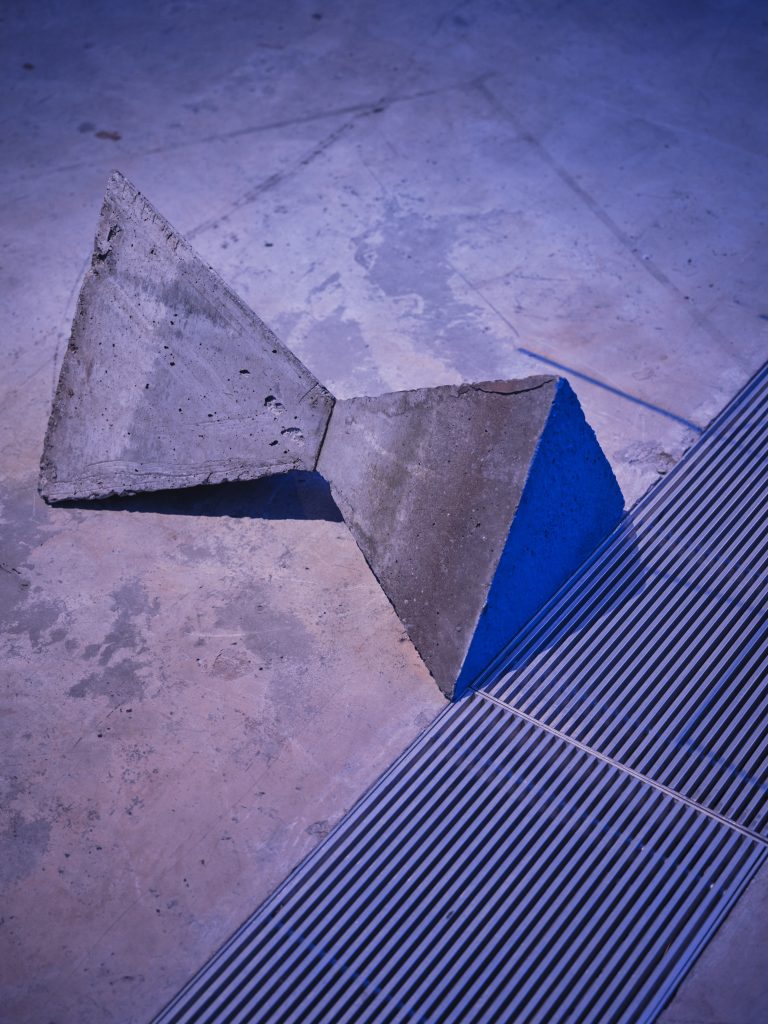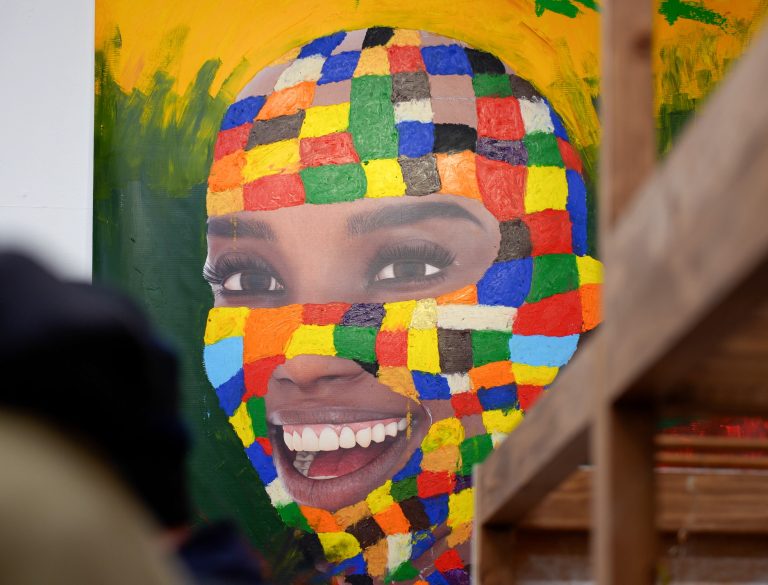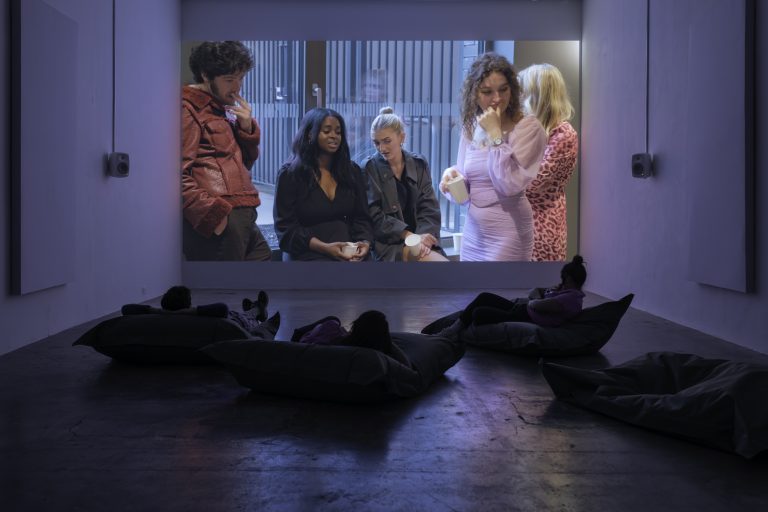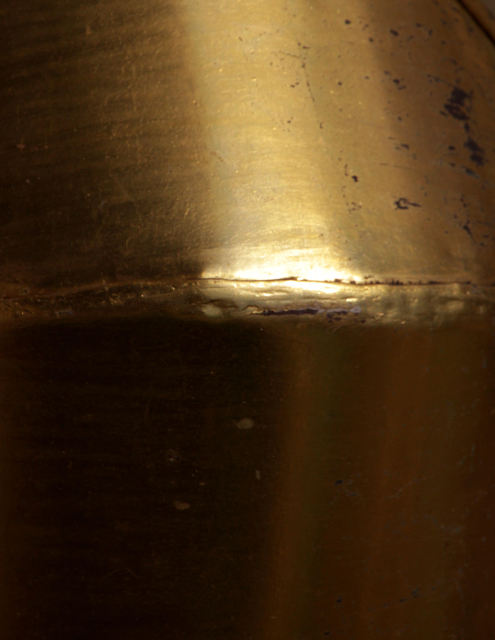An important function of architecture is its ability to engage us through movement; here, at VISUAL, the rather static, monumental space of the main gallery becomes a foil for a presentation that is all about mobility. The exhibition’s thematic touchstone, the orbiting of Earth by Yuri Gagarin in 1961, ingeniously links the viewer’s movement through the gallery space with the Russian cosmonaut’s epic voyage. Also about distance, the view of there from here, i see Earth helps close the gap between mediation and immediacy, reflecting on previous ideas and events in Tom dePaor’s practice while simultaneously focusing on the visitors’ first-hand, embodied encounter. In a previous encounter with the architect himself – in the kitchen of a house party, where all truths converge – he talked to me about Iannis Xenakis, and how the Greek composer and architect had influenced Le Corbusier. Describing the bright corridor linking the church and residential quarters of ‘Corbs’ Sainte-Marie de la Tourette, he explained how Xenakis – left in charge of the on-site works while his boss was busy in Chandigarh – had used his knowledge of music to inform the rhythmic structure of the fenestration running along one side.1 I had been entranced by this area of the complex during a recent visit, especially the changing light and shadows cast by the slender, concrete mullions. But now I understood something else about it. Nuanced by invisible sound, Le Corbusier’s modular system had been turned into kind of score, a silent music continuously rewritten by the sun. Similar material and conceptual intricacies might apply to dePaor’s own practice, which, in addition to being informed by illustrious predecessors, has its own share of unconventional thinking. And i see Earth, like the sun-raked passage at La Tourette, is also about shadows and light.
‘Material casts a shadow, and the shadow belongs to light.’2 Louis Kahn’s pithy observation personalises a phenomenon we usually regard objectively. If light can have possessions, then we must all be within its thrall. The uninterrupted volume of the main space at VISUAL is normally lit from its two longest sides. Curated and commissioned by Nathalie Weadick, in a co-production by the gallery and the Irish Architecture Foundation, for this exhibition those lofty, continuous strip windows have been discreetly covered over, so that the artificial lighting – provided by two blue-filtered film projections on opposing walls and a centrally hung blue LED light called The Birds (2022) – controls the room’s illumination.3 Synched to the projections, a soundtrack plays through a quartet of speakers positioned in the four corners of the room. Loud in the open space, the vibrato of heavy machinery appears loosely connected to the films, as though recorded from the same sites but overlaid at some later point. When the projections stop, the character of the room changes. Emerging from blue, we enter a zone of white light and noirish shadows, cast between takes on a film set shooting day for night.
Tom dePaor, i see Earth, VISUAL Carlow, installation view, 2022.
Photography by Ros Kavanagh. Courtesy of the artist and VISUAL.
The exhibition’s formal symmetries are further enhanced by a prose poem, ‘Previous, Next’ (2022), printed across 360 A4 pages and pinned side by side in a band around the gallery walls. This radius of words combines extracts of Yuri Gagarin’s account of his maiden space flight, ‘Although I knew that the behaviour of my organism was being watched on earth, I sometimes could not help listening to my own heart,’ with dePaor’s interleaved, poetic commentaries, ‘the rowdy rotunda, the sun, giddy lapping, in the porthole’.4 Reading my way around the room –making my own orbit – I encounter the architect’s playful, ‘I spy with my little eye, something beginning with,’ followed on the next page by Gagarin’s, ‘I see Earth.’
Tom dePaor, i see Earth, VISUAL Carlow, Installation view, 2022.
Photography by Ros Kavanagh. Courtesy of the artist and VISUAL.
The cosmonaut’s audacious journey privileged him uniquely, but most of us ‘see Earth’ closer to hand, and from a grounding of subjective entanglements. Depicting the individual vowels of their collective title, a series of small unframed watercolour drawings is called Aeiou (2019). These gestural works represent language but remain simultaneously personal and abstract, their semiotics as much indexical as symbolic. Displayed in various configurations around the room, they have the character of stamps or personal seals, as if to say – ‘the architect was here’. Further asserting drawing as the main focus of the exhibition, a group of very large, linear constructions – essentially, three dimensional drawings –command the centre of the room. Painted cobalt blue and made from 2 km of 6 mm round bar steel, An island, a ship, a house, a hut, the fence (2022) – a quintet alluding to the separate elements of the Willow pattern – reconstitute previously built structures by dePaor as elegant, Calderesque sculptures. Destroyed or dismantled, the objects they represent exist only as memories now, their legacy less about the physical endurance of architecture and more about the qualities of thinking it engenders. Standing on the floor or suspended from the high ceiling, these wiry armatures feel like an assembly of blue brethren, meeting in the afterlife to remember their previously embodied selves. As the ambient light switches from blue to white, the emphasis on their form also changes, with theirshadows – belonging to light – now sharply cast against the smooth, white walls. The entire staging of the exhibition – with many of dePaor’s original works also made for stages of various kinds – presents the architect’s practice as a dramatic mise en scène, a performance of objects and ideas in this specific time and place.
Working as Gall, dePaor has collaborated with multimedia artist and designer Peter Maybury over many years. Their sheet steel sculpture Temperance, originally made for EVA International (2010), greets visitors to the exhibition from a new perch on the side of the VISUAL building. Described as a nymphaeum dedicated to the shape-shifting nymph, Arethusa, the four-sided form is an inverted pyramid, with a wide mouth tapering to a much smaller footprint at its base. Open to accommodate rainwater, the resulting discharge – discoloured from oxidisation with the steel – ‘weeps’ through the spelling of ‘Arethusa’ cut out of its four lower sides.5 Referencing Greek mythology and suitably placed here, the sculptural object is both emphatic in its formal self and merely a conduit – a solid structure charged with an intermediary rite.
Tom dePaor, i see Earth, VISUAL Carlow, Installation view, 2022.
Photography by Ros Kavanagh. Courtesy of the artist and VISUAL.
In a practice constituted by impermanence as much as by that which is physically fixed, the importance of the ephemeral, and how this impacts on the archive, are central concerns in Maybury’s sixty-minute documentary film, On Being There (2022). Shown in an antechamber to the main exhibition space his film – which depicts the sifting through of existing records and mediations in the form of drawings, photographs, and published books (many of which Maybury also designed and produced) – is not merely an account of dePaor’s practice, but mirrors (Maybury describes it as a ‘skeuomorph of encounter’) the multifaceted and situated nature of the practice itself.6 Architects are naturally interested in transitional spaces; in the intervals, portals, and gaps between major events. These in-between areas are emphasised in the film by a focus on its own interstices, as the operation of light boxes, scanners, and monitors – the evolving paraphernalia of recording and archiving – not only provide visual and sonic links between different episodes, but are intrinsic to its fragmentary make-up. In its layered stylings – a digital palimpsest in some ways similar to Camille Henrot’s archive based Grosse Fatigue (2013) – the film highlights the means of production through the lens of its own filming and editing techniques.7 If you watch for long enough – the granite boulders acting as seats test you in this – you will briefly hear the architect (the film has no other voice-over) reflecting on the experience of building and the stories it produces. Speaking to the filmmaker off camera, he muses, ‘Maybe you could do it like Calvino, you know … I could be like Marco Polo, describing all the places I’ve been … except the places are not fictional, the fiction is in how you see them.’8
The objects and places of dePaor’s thirty-year practice are not directly presented here, and that’s okay, because the exhibition is a work in itself, a new fiction rather than a facsimile.9 The story of N3, the compact pavilion built with forty thousand peat briquettes for the Venice Biennale of Architecture in 2000, is already well known. The cast concrete and copper-clad pump station in Clontarf is accessible to anyone passing along the coast road. Designed by Patrick Scott, the intensely coloured windows that punctuate the angular masses of dePaor’s Pálás cinema complex in Galway can be viewed from the street, or from within the building itself. An ongoing project, Dysart, in the foothills of Bray Head, has a more personal character, and something of the slowly evolving, arcadian atmosphere of Ian Hamilton Finlay’s Little Sparta. None of these projects contain a preponderance of blue. But the world is blue all the same. Ask William Anders, who took the first colour photograph of our blue planet.10 Ask Yuri Gagarin, who saw it with his own blue eyes. Writing about the colour blue, Rebecca Solnit describes the inaccessible beauty of the distant horizon, ‘the colour of where you are not’.11 The blue of i see Earth seems to close this gap. It’s a little dreamy, and with a hint of nostalgia perhaps, but in its atmosphere everything becomes newly cast in the moment. Architecture may be about the built environment and how itis organised and inhabited over time, but it is also about the tangible presence of the here and now.
John Graham is an artist, writer and lecturer based in Dublin.
Notes
1 The convent is Le Corbusier’s final building completed in Europe (1953–61). Still occupied by a silent order of Dominican monks, guests share simple meals with the brothers in a large dining hall looking down the slope towards the town of Éveux, in the Rhône Alpes. The complex was commissioned by Father Marie-Alain Couturier, requesting the architect to ‘create a silent dwelling for one hundred bodies and one hundred hearts’.
2 The full quote from Kahn’s 1969 lecture ‘Silence and Light’ is: ‘All material in nature, the mountains and the streams and the air and we, are made of light which has been spent, and this crumpled mass called material casts a shadow, and the shadow belongs to Light.’ Cited in Thomas Schielke, ‘Light Matters: Louis Kahn and the Power of Shadow’, ArchDaily, 23 April 2013, https://www.archdaily.com/362554/light-matters-louis-kahn-and-the-power-of-shadow.
3 The film projections by Peter Maybury, jointly called These Islands (2022), are from two separate works made in Achill (2013) and Ballysadare (2017). The Achill film shows ‘Achill-Henge’, the concrete ‘stone circle’ built without planning permission on Achill Island by the developer Joe McNamara in 2011. The Ballysadare film was shot in the stone quarry at Ballysadare, Co. Sligo.
4 Travelling in Vostok 1, the Russian pilot and cosmonaut became the first human to travel into space, completing an orbit of Earth on 12 April 1961.
5 ‘Weeps’ comes from the poetic description of the work on the EVA website; see https://www.eva.ie/artist/tom-de-paor-peter-maybury/.
6 From Maybury’s accompanying wall text.
7 Camille Henrot, Grosse Fatigue (2013), video (colour, sound, 13 mins.). The work was made while the artist was in residence at the Smithsonian Institution in Washington, DC, and first seen to wide acclaim in the Venice Biennale, ‘The Encyclopaedic Palace’, curated by Massimiliano Gioni in 2013.
8 This is a reference to Invisible Cities (1972) by Italo Calvino. The book is written as an extended dialogue, with the explorer Marco Polo describing fictional cities to the emperor Kublai Khan. The first edition of this book has a painting on the cover, The Castle of the Pyrenees (1959) by René Magritte, showing a castle built upon a massive, airborne rock.
9 While this is essentially true, there are smaller objects specially commissioned for the exhibition or that have been part of previous works. These include stone carvings by Jason Ellis, a bronze sculpture by Eilís O’Connell, a Murano glass light shade by Simon Walker, and a framed drawing gifted by Richard Gorman. Three sturdy oak chairs come from the exhibition ‘Of de Blacam and Meagher’ co-curated by dePaor and Peter Maybury for the Venice Biennale in 2009
10 ‘Earthrise’ is a colour photograph of Earth taken from lunar orbit by American astronaut William Anders on 24 December 24 1968, during the Apollo 8 mission. Reflecting on the photograph fifty years later, Anders wrote, ‘We set out to explore the moon and instead discovered the Earth.’ Bill Anders, ‘50 Years After “Earthrise”, a Christmas Eve Message from Its Photographer’, space.com, 24 December 2018, https://www.space.com/42848-earthrise-photo-apollo-8-legacy-bill-anders.html.
11 Rebecca Solnit, A Field Guide to Getting Lost (Edinburgh: Canongate Books, 2006), 29.







